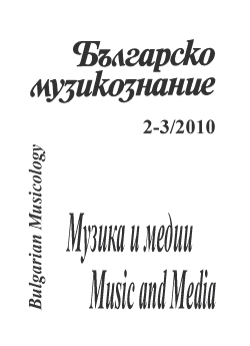За невербалната комуникация и „народните танци” като медия
On Nonverbal Communication and “Folk Dances” as Media
Author(s): Gergana Panova-TekatSubject(s): Music
Published by: Институт за изследване на изкуствата, Българска академия на науките
Summary/Abstract: In the body of the text, the author deals with the modern definition of communication, examines the achievements to date in the area of the nonverbal communication theory and is endevouring to vindicate the image of dance as a cognitive picture and primary media. In her opinion nowadays we need a new and well constructed theory of nonverbal and intracultural communication, which would not only disregard dance, but would treat it as one of the few examples of a self-contained (and not appendant to verbality) nonverbal communication. According to Gergana Panova- Tekath, dance preserves for the adult individual that degree of human intercourse, with which the child discovers itself and the surrounding world. The author speaks of the reflection of one’s own image in the person across, of the transmission of impulses, of the inability to penetrate the other’s conciousness. The body is, according to her, not only the projection screen of the concience and an intermediary in the process of communication, but a guarantor for the respect of boundaries/delineations. This, according to the author, corresponds to Post-modernity, which has accepted plurality of cultures and upholds tolerance more than it does comprehending and acceptance of the “other”. Panova-Tekath aligns theories in different scientific fields, combines terminology, announces new developments (such as the theory of the “mirrorimage neurones”), to project dancing as a “living architecture”, which extends the meaning of “I” and “We” in an infinite interpretational spiral. Dance interaction, according to the author, deals with, more often than not, the psychological window – “What none of us (me included) does not know about me”. In the second section of the text, the author pays special attention to the work of Judith Lynne Hanna, who claims that dance is a human phenomenon (“To dance is human”). In the course of a critical analysis of Hanna’s theory of nonverbal communication, the author of this paper does justice to certain concepts and terms and offers her own suggestions for the expansion of some of them, as well as for the modification of the research matrix of dance phenomena as a form of communication. The issue of how non-verbal comminication differs from verbal emerges. The specificity of dance as a form of communication originates from the three dimensionality of the body and with “synthesia” unravels into a form of mediality, which Gergana Panova-Tekath terms “existential”. With its help one can formulate and transform meanings on the cognitive, affective, sensory and motorial level. By positioning “folk dances” as an act of creation and unraveling of hidden meaning, Panova-Tekath makes a full turn and in the third part of her paper revisits the subject of identicity. She finds in the term “folk” one of the very few relatively stable images of a “group” in the course times of territorial, political and historic metamorphosis in Europe and the World...
Journal: Българско музикознание
- Issue Year: 2010
- Issue No: 2-3
- Page Range: 41-52
- Page Count: 12
- Language: Bulgarian
- Content File-PDF

